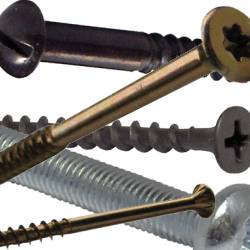How Do I Choose The Right Screw Or Fixing For My Project?
Screws and fixings are a relatively low-cost item when considering the expense of a home improvement or work project, but the function they carry out is extremely important and can lead to significant costs if you choose the incorrect screw or fixing for a job.
That said, it can be something of a minefield to survey the complex field of screws and fixings and understand what the differences are. In many cases the differences are subtle but very important, so this guide is aimed at helping you to understand those differences and how they should influence your decisions when choosing the right screw or fixing to use.
What can go wrong if I choose the incorrect screw or fixing?
Installing materials with screws and fixings is not just about keeping something in place, it is also about keeping an item aligned so that it functions properly. Screws and fixings can also withstand natural torque or unwinding, they also sometimes have a failsafe security feature and of course some of them are specifically designed to be used with certain materials.
So when the incorrect screw or fixing is used the problem may not be immediately apparent. Over time the screw or fixing may work loose or become strained, this can eventually lead to joints or pipework leaking, brackets or shelves collapsing, or a shorter lifespan for something you have constructed. This can also lead to health and safety issues, costly damage and repairs or an inferior performance from what you have put together.
What to consider when choosing the right screw or fixing
There are four main factors to consider when choosing the right screw or fixing for your project, so let’s look at these in detail:
In some cases the type of screw or fixing you need is pretty obvious. A woodscrew is suitable for fixing wood and a masonry screw is ideal for screwing into masonry. But there are also grey areas, such as MDF and chipboard, which can split more easily, and then what do you use for screwing into concrete? There are other factors to consider too, such as when screwing into masonry it is advisable to also use a rawl plug for the screw to fasten into. So essentially, the base material you are fixing will have a large bearing on what type of screw or fixing you use, but if this is not immediately obvious by the name, a quick online search should help you.
By ‘features’ we mean the thread, the tip and the head. These vary by application but there will be a combination that suits what you need the screw to do. Screws can be part or fully threaded, the tip can be blunt or pointed and heads can be rounded or flat and carry a feature which dictates how the screw is driven into the material, ie. it is slotted or crossed or countersunk. So you need to think about what tool you are using and how heavy the load is going to be.
This is not simply a case of the longer or thicker the screw, the heavier the load it can withstand, but in many cases this will apply. Generally speaking, where there is likely to be a pull force on the screw along its same axis, then a longer screw will provide more resistance, but where there will be a lateral force (ie. at 90 degrees above or below the screw) then a thicker screw will provide more load resistance. However, you don’t want too large a screw that you damage your base material, so there is a balance to be struck which sometimes comes down to common sense, particularly where the base material is a little more fragile, like plasterboard or some types of wood. You also need to be careful to understand the difference between metric and imperial sizes.
Most screws are either mild steel, stainless steel or brass, but they can also be zinc-plated, brass-plated or galvanised. Depending on your application there may be a screw material that is better for withstanding friction, or provides a better tensile strength. If the screws are to be fixed on an external construction then you want a screw material that is rust-resistant. Appearance is also a factor with screws. If you are fixing a TV cabinet in a living room, for example, you want a screw head that will sit flush to the unit and not protrude, like a flat-headed or countersunk screw, and not a rounded one. Appearance is less of an issue for external projects, but you might want to consider galvanised or stainless steel screws which are less susceptible to rust and corrosion.
In all cases it is recommended to seek specialist advice if you are unsure about which screws or fixings to use for a project. You should always be very confident you have made the right selection, so find expert advice if you are ever unsure.